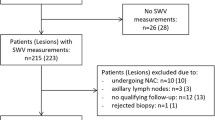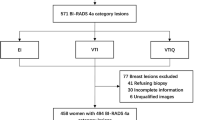Abstract
Purpose
To perform a meta-analysis assessing the ability of elastography by acoustic radiation force impulse (ARFI) technology to differentiate benign and malignant breast lesions.
Methods
PubMed, the Cochrane Library, and the Web of Knowledge before September 24, 2014 were searched. Published studies that evaluated the diagnostic performance of ARFI for characterization of focal breast lesions were included.
Results
A total of fifteen studies, including 1720 patients with 1873 breast lesions (743 cancers, 1130 benign lesions), was analyzed. Among the included studies, virtual touch tissue imaging (VTI) was used in six studies, virtual touch tissue quantification (VTQ) in eight, combined VTI and VTQ in four, and virtual touch tissue imaging quantification (VTIQ) in three. Summary sensitivity and summary specificity for distinguishing malignant from benign breast lesions were 0.913 [95 % confidence interval (CI), 0.779–0.969] and 0.871 (95 % CI 0.773–0.930) for VTI, 0.849 (95 % CI 0.805–0.884) and 0.889 (95 % CI 0.771–0.950) for VTQ, and 0.935 (95 % CI 0.892–0.961) and 0.881 (95 % CI 0.818–0.924) for combined VTI and VTQ, respectively. The area under summary receiver operating characteristic (sROC) curve of VTI, VTQ, and combined VTI and VTQ were 0.95, 0.88, and 0.96, respectively. Significant publication bias was found only in the VTQ assessment (p = 0.025). The obtained sensitivity of VTIQ ranged from 80.4 to 90.3 %, while the specificity ranged from 73.0 to 93.0 %. The summary diagnostic value of VTIQ could not be evaluated due to insufficient data.
Conclusion
Elastography by ARFI technology could be used as a good identification tool for differentiating benign and malignant breast lesions.



Similar content being viewed by others
References
Shiina T. JSUM ultrasound elastography practice guidelines: basics and terminology. J Med Ultrasound. 2013;40:309–23.
Shiina T, Nightingale KR, Palmeri ML, et al. WFUMB guidelines and recommendations for clinical use of ultrasound elastography. Part 1: basic principles and terminology. Ultrasound Med Bio. 2015;41:1126–47.
Chang JM, Moon WK, Cho N, et al. Breast mass evaluation: factors influencing the quality of US elastography. Radiology. 2011;259:59–64.
Golatta M, Schweitzer-Martin M, Harcos A, et al. Evaluation of virtual touch tissue imaging quantification, a new shear wave velocity imaging method, for breast lesion assessment by ultrasound. Biomed Res Int. 2014;2014:960262.
Ianculescu V, Ciolovan LM, Dunant A, et al. Added value of Virtual Touch IQ shear wave elastography in the ultrasound assessment of breast lesions. Eur J Radiol. 2014;83:773–7.
Kim YS, Park JG, Kim BS, et al. Diagnostic value of elastography using acoustic radiation force impulse imaging and strain ratio for breast tumors. J Breast Cancer. 2014;17:76–82.
Li Z, Sun J, Zhang J, et al. Quantification of acoustic radiation force impulse in differentiating between malignant and benign breast lesions. Ultrasound Med Biol. 2014;40:287–92.
Lo CM, Chen YP, Chang YC, et al. Computer-aided strain evaluation for acoustic radiation force impulse imaging of breast masses. Ultrasound Imaging. 2014;36:151–66.
Yao M, Wu J, Zou L, et al. Diagnostic value of virtual touch tissue quantification for breast lesions with different size. Biomed Res Int. 2014;2014:142504.
Wojcinski S, Brandhorst K, Sadigh G, et al. Acoustic radiation force impulse imaging with Virtual Touch tissue quantification: mean shear wave velocity of malignant and benign breast masses. Int J Womens Health. 2013;5:619–27.
Zhou J, Zhan W, Chang C, et al. Role of acoustic shear wave velocity measurement in characterization of breast lesions. J Ultrasound Med. 2013;32:285–94.
Ye L, Wang L, Huang Y, et al. Preliminary results of acoustic radiation force impulses (ARFI) ultrasound imaging of solid suspicious breast lesions. Chinese-German J Clin Oncol. 2013;5:219–23.
Tozaki M, Saito M, Benson J, et al. Shear wave velocity measurements for differential diagnosis of solid breast masses: a comparison between virtual touch quantification and virtual touch IQ. Ultrasound Med Biol. 2013;39:2233–45.
Jin ZQ, Li XR, Zhou HL, et al. Acoustic radiation force impulse elastography of breast imaging reporting and data system category 4 breast lesions. Clin Breast Cancer. 2012;12:420–7.
Tozaki M, Isobe S, Sakamoto M. Combination of elastography and tissue quantification using the acoustic radiation force impulse (ARFI) technology for differential diagnosis of breast masses. Jpn J Radiol. 2012;30:659–70.
Bai M, Du L, Gu J, et al. Virtual touch tissue quantification using acoustic radiation force impulse technology: initial clinical experience with solid breast masses. J Ultrasound Med. 2012;31:289–94.
Tozaki M, Isobe S, Yamaguchi M, et al. Ultrasonographic elastography of the breast using acoustic radiation force impulse technology: preliminary study. Jpn J Radiol. 2011;29:452–6.
Meng W, Zhang G, Wu C, et al. Preliminary results of acoustic radiation force impulse (ARFI) ultrasound imaging of breast lesions. Ultrasound Med Biol. 2011;37:1436–43.
Li G, Li DW, Fang YX, et al. Performance of shear wave elastography for differentiation of benign and malignant solid breast masses. PLoS One. 2013;8:e76322.
Whiting PF, Rutjes AW, Westwood ME, et al. QUADAS-2: a revised tool for the quality assessment of diagnostic accuracy studies. Ann Intern Med. 2011;155:529–36.
Berlin JA. Does blinding of readers affect the results of meta-analyses? University of Pennsylvania Meta-analysis Blinding Study Group. Lancet. 1997;350:185–6.
Dinnes J, Deeks J, Kirby J, et al. A methodological review of how heterogeneity has been examined in systematic reviews of diagnostic test accuracy. Health Technol Assess. 2005;9:1–113.
Deeks JJ, Macaskill P, Irwig L. The performance of tests of publication bias and other sample size effects in systematic reviews of diagnostic test accuracy was assessed. J Clin Epidemiol. 2005;58:882–93.
Wojcinski S, Brandhorst K, Sadigh G, et al. Acoustic radiation force impulse imaging with virtual touch tissue quantification: measurements of normal breast tissue and dependence on the degree of pre-compression. Ultrasound Med Biol. 2013;39:2226–32.
Tozaki M, Isobe S, Fukuma E. Preliminary study of ultrasonographic tissue quantification of the breast using the acoustic radiation force impulse (ARFI) technology. Eur J Radiol. 2011;80:e182–7.
Tozaki M, Saito M, Joo C, et al. Ultrasonographic tissue quantification of the breast using acoustic radiation force impulse technology: phantom study and clinical application. Jpn J Radiol. 2011;29:598–603.
Zhang YF, Xu HX, He Y, et al. Virtual touch tissue quantification of acoustic radiation force impulse: a new ultrasound elastic imaging in the diagnosis of thyroid nodules. PLoS One. 2012;7:e49094.
Xu JM, Xu XH, Xu HX, et al. Conventional US, US elasticity imaging, and acoustic radiation force impulse imaging for prediction of malignancy in thyroid nodules. Radiology. 2014;272:577–86.
Heinig J, Witteler R, Schmitz R, et al. Accuracy of classification of breast ultrasound findings based on criteria used for BI-RADS. Ultrasound Obstet Gynecol. 2008;32:573–8.
Gong X, Xu Q, Xu Z, et al. Real-time elastography for the differentiation of benign and malignant breast lesions: a meta-analysis. Breast Cancer Res Treat. 2011;130:11–8.
Author information
Authors and Affiliations
Corresponding author
Ethics declarations
Conflict of interest
There are no financial or other relations that could lead to a conflict of interest.
Ethical standards
All procedures followed were in accordance with the ethical standards of the responsible committee on human experimentation (institutional and national) and with the Helsinki Declaration of 1975, as revised in 2008 (5). Informed consent was obtained from all patients for being included in the study.
Additional information
BaoXian Liu and YanLing Zheng contributed equally to this work.
About this article
Cite this article
Liu, B., Zheng, Y., Shan, Q. et al. Elastography by acoustic radiation force impulse technology for differentiation of benign and malignant breast lesions: a meta-analysis. J Med Ultrasonics 43, 47–55 (2016). https://doi.org/10.1007/s10396-015-0658-9
Received:
Accepted:
Published:
Issue Date:
DOI: https://doi.org/10.1007/s10396-015-0658-9




